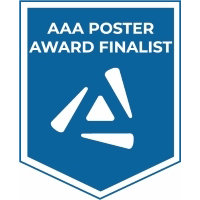Back
ANATOMY
Category: Anatomy
Session: 474 Anatomy Education
(474.9) Students Perception of the Anatomy Educational Environment at Regional Medical Campuses (RMC) and Main Campus
Sunday, April 3, 2022
10:15 AM – 12:15 PM
Location: Exhibit/Poster Hall A-B - Pennsylvania Convention Center
Poster Board Number: C9
Introduction: AAA has separate poster presentation times for odd and even posters.
Odd poster #s – 10:15 am – 11:15 am
Even poster #s – 11:15 am – 12:15 pm
Introduction: AAA has separate poster presentation times for odd and even posters.
Odd poster #s – 10:15 am – 11:15 am
Even poster #s – 11:15 am – 12:15 pm
Kyle Robertson (Indiana University School of Medicine), Elizabeth Agosto (Indiana University School of Medicine), Leslie Hoffman (Indiana University School of Medicine), Andrew Deane (Indiana University School of Medicine), Jessica Byram (Indiana University School of Medicine)
Kyle Robertson
Presenting Author
Indiana University School of Medicine
Presenting Author(s)
Introduction: In 2006, the Association of American Medical Colleges (AAMC) recommended to increase medical school enrollment to address an anticipated physician shortage in the future. To accommodate this increase, medical schools not only increased students enrolled at existing medical schools, but also opened new regional medical campuses (RMCs). However, the Liaison Committee on Medical Education (LCME) has standards for medical schools with more than one geographically separate campus; specifically, the curriculum should have comparable educational experiences, equivalent methods of assessment, and uniform graduation standards across all locations. Thus, RMCs have the unique task of maintaining an autonomous identity with their own strengths and resources, all the while remaining consistent and comparable to the central campus. Indiana University School of Medicine has eight RMCs and a main campus in Indianapolis. The first-year Human Structure course integrates gross anatomy, histology, and embryology and utilizes identical learning objectives, assessment, and state-wide pre-recorded lectures. This instructional design leaves the local educational team, cohort of students (75% fewer students at RMCs), and the campus climate among the differences in learning environment. The goal of this study is to explore the differences in medical students’ perceptions of the anatomy environment at RMCs versus the central campus despite comparability in formal curriculum.
Methods: This IRB-approved study used a modified version of the Dundee Ready Educational Environment Measure, that included a 40-item Likert survey and six free response questions to gather more information about the medical education environment. First-year medical students were recruited from three RMCs and main academic campus. A Mann Whitney U test was used to compare survey responses of participants at RMCs and main campus (α ≤ .05) and free responses comments were analyzed using thematic analysis.
Results: A total of 15 RMC (21%) and 12 main campus students (9%) completed the survey. Students at the main campus reported significantly lower scores on 10 items compared to RMC participants (p ≤ 0.035). These items related to stimulating learning, providing student-centered instruction, offering constructive feedback, and having a relaxed laboratory learning environment. Thematic analysis of free responses was consistent with survey results and demonstrated that students at RMCs appreciate the smaller number of students which provides more opportunity for one-on-one instruction, support, and camaraderie among peers.
Discussion: In considering the learning experience of students, the contributions of factors beyond the formal curriculum need to be explored. Thus, the interaction of instructor and student, through empathy, support, communication, and the learning environment as a whole need to be considered and developed. Allowing the unique qualities and identities of the RMC and central campus to flourish can improve the learning environment while maintaining comparable curriculum standards.
Methods: This IRB-approved study used a modified version of the Dundee Ready Educational Environment Measure, that included a 40-item Likert survey and six free response questions to gather more information about the medical education environment. First-year medical students were recruited from three RMCs and main academic campus. A Mann Whitney U test was used to compare survey responses of participants at RMCs and main campus (α ≤ .05) and free responses comments were analyzed using thematic analysis.
Results: A total of 15 RMC (21%) and 12 main campus students (9%) completed the survey. Students at the main campus reported significantly lower scores on 10 items compared to RMC participants (p ≤ 0.035). These items related to stimulating learning, providing student-centered instruction, offering constructive feedback, and having a relaxed laboratory learning environment. Thematic analysis of free responses was consistent with survey results and demonstrated that students at RMCs appreciate the smaller number of students which provides more opportunity for one-on-one instruction, support, and camaraderie among peers.
Discussion: In considering the learning experience of students, the contributions of factors beyond the formal curriculum need to be explored. Thus, the interaction of instructor and student, through empathy, support, communication, and the learning environment as a whole need to be considered and developed. Allowing the unique qualities and identities of the RMC and central campus to flourish can improve the learning environment while maintaining comparable curriculum standards.

